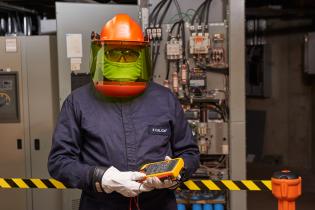Article
Limiting workers’ exposure to electrical hazards like arc flash or electrocution is a solid foundation for any electrical safety program. Combine that mindset with the right non-contact tools and more electrical workers will be kept out of harm’s way.
Article
Late on a Sunday afternoon the Kern County Fire Department responded to a call at a store on Rosedale Highway in Bakersfield, California. Crews found that a row of solar panels on the roof had caught fire. Some of the panels were still live when the crew arrived, so the fire crew had to take extra precautions until electrical power could be disconnected.
Article
Isolating circuits and equipment require a thorough risk assessment—these tips are a good starting point. Free downloadable visual guide suggests 12 steps for isolating circuits.
Article
Take digital multimeter safety precautions to handle the conditions found in your work environment. Understand multimeter CAT ratings and ingress protection (IP) codes.
Article
To meet the demands of today’s high-energy, high-hazard workplace, quality manufacturers like Fluke continue to improve their test instruments to make them safer and more reliable.
Article
Placing electrical equipment or systems in an electrically-safe work condition might seem simple, but there are several factors to consider.
Article
The arc flash boundary is the minimum “safe” distance from exposed energized conductors or circuit parts that has the potential for an arc flash. The required arc-rated clothing and PPE increases rapidly as a worker approaches the potential source of an arc flash
Article
Arc flash vs arc blast. When an arc fault occurs, the result is a massive electrical explosion. The light and heat emitted by the explosion is known as the arc flash, and the pressure wave is known as the arc blast.
Article
Avoiding arc flash hazard at an asphalt plant where safety is a top expectation, with the use of Fluke wireless tools.
Article
The effective date of the latest version (the 2011 edition) of NFPA 70: National Electric Code” (NEC) was August 25, 2010. It was published in September 2010.
Article
Electrical safety requirements for using digital multimeters per OSHA and NFPA 70E
Article
Insulated electrical tools are critical for electrical safety.
Article
Watch Fluke electrical safety videos. Avoid dangerous arc flash explosion accidents and other deadly industrial electrical shock hazards. Select the right PPE, design and test standards, NPFA PPE table method.
Article
Mixing higher voltage 480-volt three-phase cables in the same cabinet as lower voltage 24- or 120-volt control wiring and communication cabling can result in erratic operation or even complete failure of electronic equipment inside the cabinet. Knowing what is inside the cabinet before you open it, the specific wiring issues to look for once inside, what values to measure, and simple ways to correct problems can help alleviate many erratic and sometimes "mysterious" control and communication issues on the plant floor.
Article
IEC Category Ratings: Use the Right Tools for the Job.As with appropriate personal protective equipment (PPE), using the proper tools for the job can help keep electrical workers safe.
Article
Working on live circuits is probably most electricians' least favorite task. But sometimes it's the only way to get the job done.
Article
Out on the job site, concrete finishers stand ready to shape wet ready-mix into a new stretch of highway. Mixer trucks are lined up at the concrete batch plant,waiting to take on their loads. But hold on—an electrical problem has shut down the plant. It's time to call Keithly Electric.
Article
Inductive heating, which typically occurs when phase conductors are routed around metal mounting channels, supports, or braces, can cause catastrophic and deadly failures in electrical distribution and control equipment.
Article
Thresholds between solenoid-based testers and electronic testers are markedly different and carry consequences for safety and convenience.
Article
Learn how Fluke shifted resources to meet the global demand for PPE face shields in the fight against COVID-19.
Article
The North American Board of Certified Energy Practitioners (NABCEP) offers certifications and certificate programs geared toward renewable energy professionals throughout North America, including a certification program for solar electric installers.
Article
Fluke TwistGuard™ Test Leads:safer, tougher, more versatile
Article
Curb explosive potential with intrinsically safe tools. For those who work in industries where flammable materials are present—such as petrochemical and pharmaceutical plants, oil platforms, refineries, pipelines, and mining—the potential for an explosion is a daily reality. All it takes is a flammable material coming into contact with air and an ignition source.
Article
Anyone who makes their living by working with electricity quickly develops a healthy respect for anything with even a remote chance of being "live." Yet the pressures of the getting a job done on time or getting a mission-critical piece of equipment back on line can result in carelessness and uncharacteristic mistakes by even the most seasoned electrician.
Article
Following electrical safety regulations in industrial plants is critical. But myths about electrical safety are rampant. Understand the facts vs myths about working in energized systems.
Article
How to cultivate a company culture where employees take the necessary steps to build a culture of safety
Article
How to perform risk assessments when using Energized Electrical Work Permits (EEWPs). Anyone working with electricity is responsible for electrical safety and identifying hazards.
